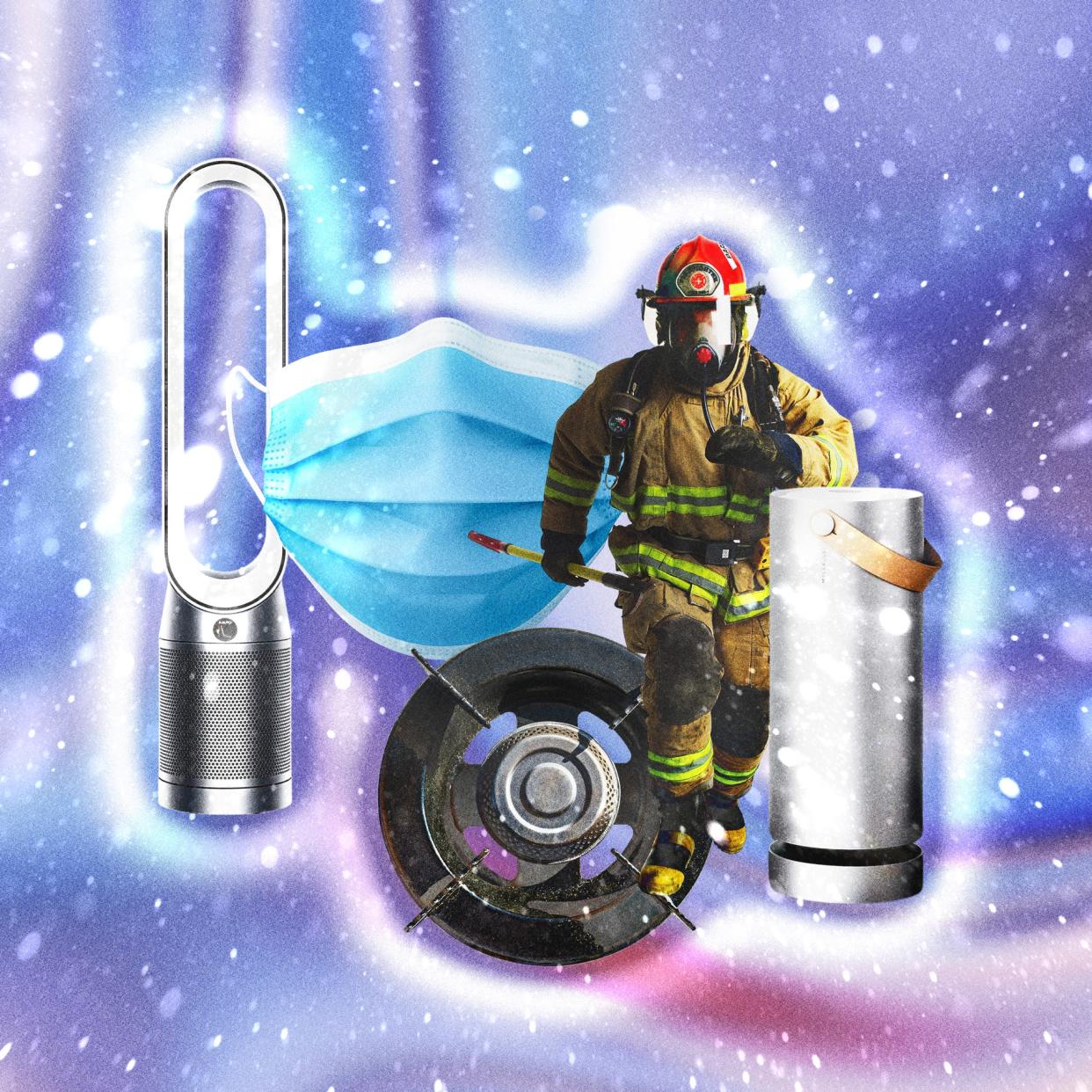2023: The Year We Got Serious About Air Quality

GQ; Getty Images
In the best scenarios, we don’t really think about the quality of the air we breathe. But thanks to COVID-19, a gas stove chapter in the culture war, and the United States getting shrouded by Canadian wildfire smoke, air quality has been thrust into the U.S. collective consciousness in 2023.
The World Health Organization says that 99 percent of the human population breathes air that exceeds its guideline limits “and contains high levels of pollutants, with low- and middle-income countries suffering from the highest exposures.”
In New Delhi, the regularly smoggy air is described as an “invisible killer,” according to Jyoti Pande Lavakare, an author and clean air non-profit co-founder. Further south in India, Mumbai’s air quality also draws comparisons as a lethal force, resulting in some 29,000 deaths in 2023 alone. In October, the smog around Beijing prompted an emergency response, including flight delays and temporary highway closures. These circumstances have left cities scrambling to deploy anti-smog machines meant to neutralize lingering dust particles, though they’re seen as temporary relief to a much more gaping and existential threat.
While the air quality has largely improved in the United States since 1980, according to the Environmental Protection Agency, a recent study shows that in the western United States, air quality has gotten worse from 2000 to 2020, as emission reduction efforts were disproportionately countered by an increasing number of wildfires, which also increased in intensity. A paper published in Nature in November confirmed that poor-quality air—a leading cause of death in the United States—disproportionately affects Black people.
And this year, the smoke wasn’t exclusive to the West. Due to a record amount of wildfires in Canada, New York City’s air quality index (AQI) temporarily made it one of the most air-polluted places in the world, ranging from “Unhealthy for Sensitive Groups” to simply “Unhealthy” for everyone. On Wednesday, July 8, The Guardian reported that the United States had the worst air pollution from wildfire smoke in recent history, which can result in ill-advised health effects ranging from eye irritation to premature death.
Black carbon—the air pollutant that's culpable for these deaths—increased by 55 percent in the western U.S., mostly because of wildfires, with climate experts warning that air quality will only continue to get worse with climate change and affect people who were previously insulated from its reach.
The kicker? While the air outside has been making headlines for its less-than-stellar 2023 performance, indoor air quality remains up to five times more polluted, and we were again reminded of this when a fossil-fuel-support-signaling spectacle outshined a serious issue.
Richard Trumka Jr., a commissioner of the U.S. Consumer Product Safety Commission (CPSC), told Bloomberg that the CPSC was considering a ban on gas stoves—which occupy 40 percent of American homes—given that they release methane and nitrogen oxide, which account for 13 percent of childhood asthma cases in the United States, can cause health and respiratory issues in adults, and have the carbon dioxide emissions equivalent of 500,000 cars.
Naturally, politicians like Florida Governor and Republican presidential hopeful Ron DeSantis bravely claimed that Brandon would not get another wink of sleepytime until he personally removed the gas range from your home. Then, in May, New York made history by becoming the first state to introduce a ban on natural gas stoves and furnaces in most new construction—with exceptions like large commercial buildings—requiring fully electric heating and cooking in buildings shorter than seven stories by 2026.
Contributors to indoor air quality can include gas stoves, but also cleaning solutions, air fresheners, candles, plus whatever’s in the outdoor air—which enters via cracks, doorways, and ventilation systems. As the pandemic led many people to live an even more indoor lifestyle (and kept us wanting to mitigate the risk of airborne particles carrying the disease), companies like Dyson, Mila, and Molekule capitalized on the journey inward, transforming clunky air purifiers into well-designed status symbols. To meet our current-day dystopia, Dyson even launched the Zone, a pair of noise-canceling headphones that can also blow filtered air into your face.
As the reasons to be concerned about the air quality mount, let’s talk through what you have control over. While you might not be able to prevent all forest fires, remove your gas stove, or replace your office’s HVAC system, it’s not a bad time to look into air purifiers with HEPA filters (like those above) to monitor your abode so you can change certain habits that might be affecting the air quality—like burning candles, cooking with gas, or spraying solutions that are smogging up your air. And if you want to give gasless cooking a shot, there are portable induction cooktops that only use electricity, heat up faster, and don’t emit any of the toxic fumes associated with gas burners.
You can also support policymakers in creating legislation that impacts how we fight the climate crisis, which impacts the air we breathe. In November, for example, the Biden administration announced a $2 billion fund through the EPA to “support community-driven projects that deploy clean energy, strengthen climate resilience, and build capacity for communities to tackle environmental and climate justice challenges,” including air pollution monitoring and prevention.
Whatever we’re doing to address air quality, there’s much more left to be done. As the WHO states, measures to improve air quality “offer a win-win strategy for both climate and health, lowering the burden of disease attributable to air pollution, as well as contributing to the near- and long-term mitigation of climate change.”
Originally Appeared on GQ

